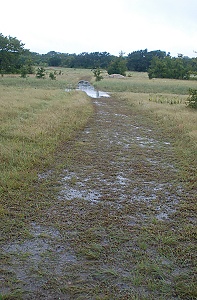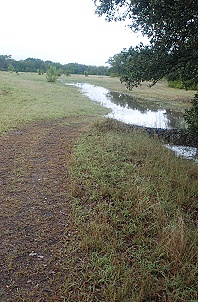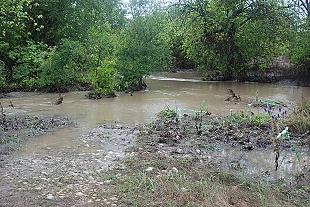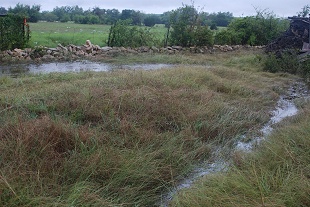…means plenty for wildlife to drink. And plenty for us to rejoice over. And me to wade in, while going out to take pictures of this bounty. Here’s a view of the near meadow…you can compare it to the July 6 picture…

I ventured out between rains to get some pictures, with the camera in a plastic zipper-bag and a rain jacket just in case (wise decision–the rain caught me later in the walk) and since it was so warm decided to wear shorts and mesh wading shoes instead of jeans and rubber boots. It was fun to wade in the ankle-deep water draining off the grassland, as in the near meadow.
Below the dry woods, there’s a dip we call the dry woods swale–it’s almost a spring, though it also captures runoff. We put a gabion at the low end to slow the runoff and hold water up there a little longer.

This picture faces sort of west, and I headed northwest to reach the north fenceline at the creek. My husband had already been along the south fenceline and said the creek was out of its banks there, and the overflow channels were also full (hurray!) but I wanted to see the north end. The north end is the only place we can get vehicles across (and only after we put rocks.) But nothing’s crossing there today:

The creek was fairly roaring (I could hear it by the time I was halfway across the west grass), and though it was falling (you can tell by the “collars” of flotsam on the bushes and small trees) it hadn’t fallen enough.
At about this time–as far from the house as I could get–I looked back to the east and saw the next rain coming. So I tucked the camera back in its plastic bag, tucked that under my arm and pulled the rain jacket over it, and hiked back. The rain wasn’t heavy (then–it’s been heavier again since) and was pleasant to walk in. I did pause at the west end of the near meadow to photograph the streams of water that drain across it (starting up at the highway or on the other side–there’s a culvert.) Our various check-dams and gabions slow the water and hold some of it back, but a lot goes on through. The rocks piled against the fence are supplementing a gabion there–runoff used to roar through a gap gate at the corner, diggins it deeper (and undermining the corner post) but the gabion and rocks have pretty much stopped that.

Both these channels were cow-paths, deepened by erosion, when we got the place.
Wonderful, wonderful rain.
Comment by Tom Hise — September 12, 2009 @ 6:38 pm
So glad you got the rain you so desperately needed. Hope you get the appropriate follow-up amounts.
Comment by Chuck — September 12, 2009 @ 9:33 pm
“Gabion” was a new term for me, so I looked it up. Am I correct in assuming that what you use is similar to the blackish fabric (plastic?)tubes or cylinders I’ve noticed over the past few years, mostly near housing additions or highway construction? That is, where the natural ground cover has been bulldozed or otherwise removed?
Comment by elizabeth — September 12, 2009 @ 10:10 pm
No, what we use is chain-link fencing–some salvaged from a fence we removed from the back yard, and some scrap sections bought for less than the usual amount, and held together with hog rings. Filled with rocks we picked up. They look like long sausages. The state buys (or makes) some square-section wire-mesh gabions that look more like chicken-wire than chain-link (you could use chicken wire, but it won’t last as long.) The galvanized chain-link fencing will last a long time.
The last picture on this page shows the #3 gabion as Richard extended it:
The little frame near this end was to hold the end of the “sausage casing” open so we could shove rocks inside.
Comment by elizabeth — September 12, 2009 @ 10:11 pm
Thanks, Tom. It looks like we have (we’re over 7.5 inches now. )
Comment by Chuck — September 13, 2009 @ 12:11 pm
Thanks for the linkto the photo, which really makes it clear – I had pictured something much smaller and more temporary. This really is a more permanent structure.
On my childhood home-place in Parker County, most of the earthworks/terrain manipulation my dad made involved only soil – terracing, small levees, and so on. There weren’t many rocks available, and besides, my dad grew up in a non-rocky area of Mississippi and was mostly familiar with mounded earth. But where he lives now, just a few miles from our old place, has abundant rocks. I’ll have to discuss with him the possibility of using gabions.
Comment by elizabeth — September 13, 2009 @ 2:29 pm
Soil constructions can certainly help, but have the disadvantage that if water can overtop them and you don’t have some protection on the spillway (concrete or grass) they’re prone to erosion themselves.
Full dams (of any material) increase the vertical drop (and thus velocity and erosive power) of the water on the downstream side and thus are not the ideal erosion control structure in my opinion.
Check dams are another good possibility, but since they’re made of loose rock, they can be torn (usually just part of the dam) by fast water–if the water can shift the rocks individually. Checkdams should be longer (in the direction of flow) than they are wide (across the flow) to reduce this problem, especially when built across narrow channels. Soil checkdams with sufficient tough grass on them can work.
Gabions have the great advantage that the water must be able to move the total weight of the gabion–much more than any one rock–to shift the whole thing, and the
Fencing companies often have odd pieces of chain link left over from jobs…they don’t give them away, but since they’re not likely to be all that useful in a standard fencing job, they sell them cheap. Or chicken wire or any other galvanized mesh-wire (depends on the size of rocks, of course.)